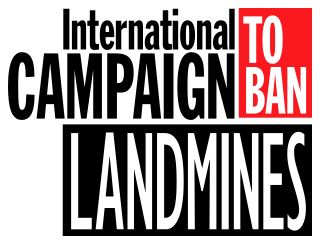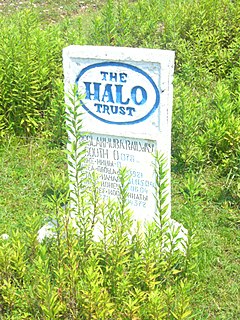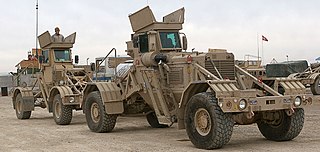
A land mine is an explosive device concealed under or on the ground and designed to destroy or disable enemy targets, ranging from combatants to vehicles and tanks, as they pass over or near it. Such a device is typically detonated automatically by way of pressure when a target steps on it or drives over it, although other detonation mechanisms are also sometimes used. A land mine may cause damage by direct blast effect, by fragments that are thrown by the blast, or by both.

The International Campaign to Ban Landmines (ICBL) is a coalition of non-governmental organizations whose stated objective is a world free of anti-personnel mines and cluster munitions, where mine and cluster munitions survivors see their rights respected and can lead fulfilling lives.

The HALO Trust is a non-political and non-religious registered British charity and American non-profit organization which removes debris left behind by war, in particular land mines. With about 6,000 deminers worldwide, HALO's largest operation is in Afghanistan, where the organization operates as an implementing partner of the Mine Action Programme for Afghanistan (MAPA).

Demining or mine clearance is the process of removing land mines from an area. In military operations, the object is to rapidly clear a path through a minefield, and this is often done with devices such as mine plows and blast waves. By contrast, the goal of humanitarian demining is to remove all of the landmines to a given depth and make the land safe for human use. Specially trained dogs are also used to narrow down the search and verify that an area is cleared. Mechanical devices such as flails and excavators are sometimes used to clear mines.

FSD is a Swiss non-governmental organization involved in mine action. FSD is politically, ideologically and religiously independent. FSD is based in Geneva, has national field offices in its countries of operation as well as a logistical and administrative support office in Manila. From 2005 FSD was joined by its French partner FSD France, and from 2007 by CROSSTECH SA, a mine action company which is fully owned by the FSD.
A mine clearance organization, or demining organization, is an organization involved in removal of landmines and unexploded ordnance (UXO) for military, humanitarian, or commercial reasons. Demining includes mine clearance, as well as surveying, mapping and marking of hazardous areas.

Anti-personnel mines are a form of mine designed for use against humans, as opposed to anti-tank mines, which are designed for use against vehicles. Anti-personnel mines may be classified into blast mines or fragmentation mines, the latter may or may not be a bouncing mine.

The region of Nagorno-Karabakh is considered to be one of the most heavily mined regions of the former Soviet Union. Mines were laid from 1991-1994 by both Azerbaijani and Armenian forces during the Nagorno-Karabakh War.
The PRB M3 and PRB M3A1 are plastic cased minimum metal anti-tank blast mine produced by the Belgian company Poudreries Réunies de Belgique in the 1970s and 1980s. The mine is square with an olive drab body constructed from polythene with a webbing carrying handle on the side and an ammonia-free bakelite seating for the pressure plate to be screwed into. The fuze well is in the centre of the seating, with the pressure plate screwed into it after the fuze has been inserted. The cylindrical pressure plate consists of two plastic plates, one of which moves under the weight of a vehicle driving over the mine to transmit the force to the fuze, shearing pins which hold it in place.
The M24 mine was a United States off-route land mine based on the M28A2 HEAT rocket normally fired by the M20 3.5 inch rocket launcher. The rocket was launched from an M143 plastic launch tube.
As of 2004, Chechnya was the most land mine-affected region in the world.

Aardvark JSFU Mark 4 is a British-made Mine flail vehicle built by Aardvark Clear Mine Limited registered in Dumfries, Scotland.
Mine action is a combination of humanitarian aid and development studies that aim to reduce the social, economic and environmental impact of landmines and the explosive remnants of war (ERW).

The Husky VMMD family of vehicles are blast-survivable, mission-configurable wheeled platforms employed around the world by specialized route clearance teams operating in high-explosive threat areas. Defined by their unique design characteristics of survivability, frangibility, and reparability, Husky vehicles enable personnel and payloads to safely operate in close proximity to sub-surface explosive hazards.

The Mines Advisory Group (MAG) is a non-governmental organization that assists people affected by landmines, unexploded ordnance, and small arms and light weapons.

The Pookie MRAP vehicle was created to deal with the constant mining of the roadways during the Rhodesian Bush War.

The United Nations Mine Action Service (UNMAS) is a service located within the United Nations Department of Peacekeeping Operations that specializes in coordinating and implementing activities to limit the threat posed by mines, explosive remnants of war and improvised explosive devices.
The Crocodile Armoured Personnel Carrier or "Croc" is a Rhodesian armoured personnel carrier first introduced in 1977 and based on Japanese commercial trucks' chassis. It remains in use with the Zimbabwe National Army.
MineWolf Systems provides machines and services for the mechanical clearance of landmines and other explosive devices. Its customers are mine clearance agencies in the commercial, humanitarian and military demining field. British company Pearson Engineering Ltd, a leading provider of Combat Engineer equipment, announced acquisition of the IP and Assets of MineWolf Systems in 2016.
The Mine Kafon Drone is a drone for demining, led by Afghanistan-born Massoud Hassani. The drone is designed to map an area for land mines, detect the mines, and then detonating them remotely. It has been field-tested with the Dutch Ministry of Defence. The use of a drone is safer and less expensive than typical methods for mine removal, which endanger trained mine disposal experts and dogs. The Mine Kafon Foundation, established by Hassani in 2013, is based in Eindhoven, Netherlands.











